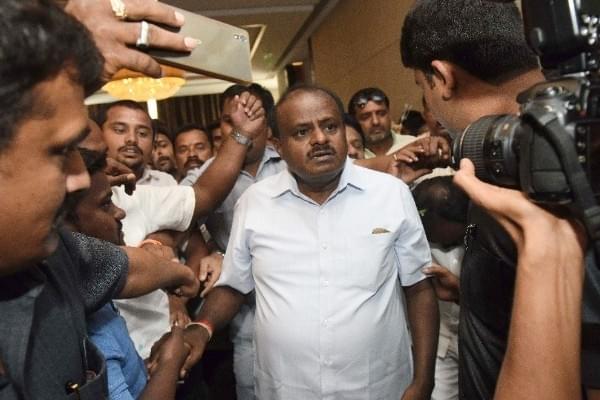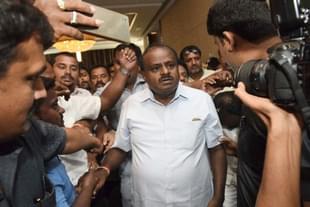Politics
Karnataka Budget: Boon To Farmers, Bane To Middle Class
Sathyajith M S
Jul 08, 2018, 09:56 AM | Updated 09:56 AM IST
Save & read from anywhere!
Bookmark stories for easy access on any device or the Swarajya app.


The Congress-Janata Dal (Secular) government headed by H D Kumaraswamy, in its annual budget, has waived off farm loans worth Rs 34,000 crore. The Chief Minister, who is also the Finance Minister, announced this in his budget speech. Though it is going to benefit the farmers in the short run, one really does not know about its feasibility in the long run. To generate funds for the loan waiver, the government has considered the easiest option of increasing taxes on petrol and diesel, without weighing in any other alternatives.
There has been an allocation of Rs 10,500 crore for the loan waiver in the current fiscal. Considering the fact that this will be clubbed with the loan waiver announced by former chief minister Siddaramaiah and around Rs 4,000 crore having already been spent on it, Rs 6,500 crore will be the additional burden for the government. Therefore, the question that arises is whether the increase in various taxes, which will be mainly borne by the tax-paying middle-class citizens, is justified. The government has increased taxes on diesel and petrol by 2 per cent from 19 per cent and 30 per cent respectively. Ironically, the Congress had recently demanded that the Narendra Modi-led Union government reduce the taxes on petrol and diesel as it was a “burden” on the “common man”.
The increase in taxes on petrol and diesel means that for every subsequent increase in fuel prices, the taxes will rise consequently. Is this in any way justified to generate a pool of fixed funds for a particular purpose? Could the government not think of any other alternative before resorting to the easiest way out? These questions go unanswered.
The coterie of economists who advised this government have probably not thought of the cascading effects these measures will have. The Economic Survey 2017 had clearly pointed to the adverse effects farm loan waivers bring about. It had pointed to the deflationary impact of farm loan waivers. Apart from this, the government has probably failed to gauge the inflationary impact of increasing taxes on petrol and diesel. It has not considered the fact that farmers, too, use diesel for their tractors as well as electricity, just as any other common man (pump sets for irrigation purposes are not charged), and this will mean that farmers will have to spend more to produce, harvest, and transport the crops to the market.
For the urban middle class, apart from spending more on private transport, they may have to shell out more even for public transport, as transport corporations may increase their fares owing to higher fuel costs.
The government has also increased taxes on motor vehicles that provide private services by 50 per cent. According to government estimates, this would generate an additional amount of just Rs 56 crore. This comes at a time when we have been discussing ways to ease the congestion on our roads. This deters smaller companies from hiring private services for providing transport facilities to their employees. Big corporations may be able to absorb this increase, but smaller companies may now ask their employees to travel on their own by providing them travel allowances. This may increase the use of private vehicles over public transport, which means the traffic menace will only increase.
“Investors are coming to Karnataka mainly because of its competitiveness. Transportation costs are a major head for any large company, and any increase in taxes will weaken us,” said K T Rajashekhara, Managing Director at SRS Travels, according to a report in the Economic Times.
To honour his election promise, the Chief Minister has neglected fiscal prudence. Despite increasing taxes, the fiscal deficit is set to rise to 2.89 per cent of gross state domestic product (GSDP). The state’s liabilities are also set to rise by around Rs 6,000 crore from 20.36 per cent of GSDP to 20.75 per cent of GSDP. The difference between the farm loan waiver in Uttar Pradesh and Karnataka is the fact that despite waiving off loans, the fiscal deficit of Uttar Pradesh reduced while it is all set to increase in Karnataka.
Coming to the alternatives, the government had to find ways to generate funds; one could be regularisation of all Bengaluru Development Authority (BDA)-approved sites by asking the owners to pay guideline charges, the other was imposing a cess specifically for “farmers welfare” on fuel instead of increasing the taxes. These two measures coupled with plugging of leakages in delivery of public services would have sufficed.
The increase in cess here is a secondary option, whereas the government has raised taxes on petrol as a primary option. This author fundamentally does not believe farm loan waivers are a solution to the farmer’s problems and, if a government decides to do it anyway, it should not shift the burden of it on the urban, middle-class taxpayer.
It can now be said clearly that the government has not been very sensible, and this budget has become more like a populist, Mysuru-Bengaluru-oriented budget.
Sathyajith’s areas of interest are politics, economics, and history.





